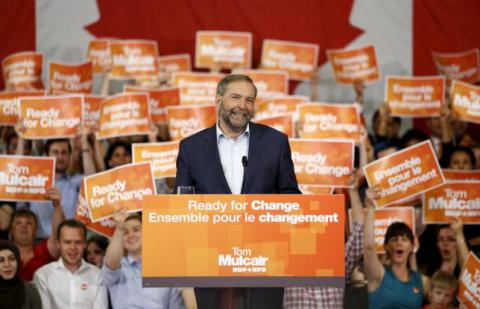The subtext of election 2015 is that the NDP could win the most seats in the next parliament, and the other contenders have turned against them.
After spending two-plus years and untold amounts of dollars telling Canadians that Justin Trudeau was Just Not Ready, the Conservatives discovered that the NDP were a major beneficiary of the negative advertising ordered up by Stephen Harper.
A year ago, in September, the Liberals looked like the main vehicle to channel the anti-Harper sentiment that prevails among two-thirds of Canadian voters. By this August, coming into the election, with the help of Conservative ads, the Trudeau Liberals had taken themselves from first to third. A series of ill-advised moves, culminating in support for the Conservative Bill C-51, a.k.a. secret-police-enabling legislation, validated Conservative claims about Trudeau.
Unlike his father, Trudeau fils loves to campaign, enjoys crowds and tirelessly meets voters. A key storyline of the first eight weeks of the campaign is the Liberals clawing themselves back into contention for the anti-Harper vote, thanks to their leader's performance on the hustings.
The Conservative campaign has been overshadowed by bad news. Testimony about Senator Duffy fundraising on public money was followed by coverage of charges against Harper top aide Bruce Carson for fraud and influence peddling. As if criminal wrongdoing blocking out Conservative campaign messages was not enough, Statistics Canada announced six months of negative economic growth and a second Conservative recession in less than 10 years.
Dissension within the campaign team sent Harper to the phone. The political consultant that helped David Cameron win a majority in the U.K., the Aussie "Lizard of Oz" Lynton Crosby is reshaping the Harper campaign.
Crosby wants to "excite" the electorate, wedge voters away from the opposition.
Harper is now talking about how the NDP or Liberals would lead Canada into a swampland with government spending and new taxes. His campaign branding has shifted to "Protect our Economy" from "Proven Leadership."
Creating fear of "others" is a mark of campaigns where Crosby has been active. Generating emotion over asylum seekers as a security threat is the Conservative application. The Syrian refugee crisis is to be exploited by the Conservatives: refugees are to be feared, not re-settled. A recent householder depicts NDP Leader Tom Mulcair as a friend of the Islamic State (ISIS) because he wants to admit more refugees (in line with what the UN has suggested) and end Canadian bombing missions over Iraq and Syria.
With the spotlight directly on the shortcomings of his government, Stephen Harper tries to capitalize on normal fears about the future and turn them into fear of voting NDP. This means identifying Muslims as a threat to Canada and talking about "old stock" Canadians, to create divisions within the electorate that Conservatives can exploit.
This Crosby tactic is called "throwing a dead cat on the table."
With the NDP making headway talking about child care, championing manufacturing, improving pensions, and bringing in public coverage for drugs or pharmacare, the Conservatives change the subject by putting a divisive issue like wearing a face covering (a niqab) onto the public agenda. The Harper campaign then gets attention diverted away from Conservative failures.
The Bloc have borrowed from the Lynton Crosby playbook and used a video to call out Mulcair around the issue of Muslim women being allowed to wear a niqab covering their face while voting, and not just for a citizenship ceremony.
The NDP have drawn upon the tested Jack Layton campaign team to warm Canadians to his successor. Wary of attracting attention as a frontrunner, the image being projected is of a "prime ministerial" Tom Mulcair, not just an adversarial Leader of the Official Opposition.
At the Calgary leaders' debate, Mulcair was careful to distance himself from the two other leaders. For Mulcair, Harper has hit the "snooze button" when Canada faces long-term challenges to protect the environment and grow the next economy, while Trudeau wants to hit the "panic button" with short-term borrowing as a solution to deep-seated structural problems left behind by Liberals and Conservatives in turn.
Political parties slip to the centre at election time in search of wavering voters. The NDP's cautious approach to policy appeals to a target audience of people who have never voted NDP before. However, talk of balanced budgets, and going slow on investment in child-care spaces irritates party supporters.
One of the principles employed by the Lizard of Oz is to divide the opposition parties, get members squabbling amongst themselves. The Conservatives (and the Liberals) would like nothing better than to see NDP candidates break ranks or have prominent party members denounce the leader.
The Liberal party has dragged up what contradictions they could find in Tom Mulcair in his former life ... as a Liberal. Liberal strategists want to drain confidence in Mulcair from NDP supporters.
Mounting attacks on the NDP leader instead of focusing on bringing down Harper signals the Liberals are neglecting the anti-Harper voters Justin Trudeau needs to form a government.
The Liberals want to see the NDP stumble, so as to improve their current 36-seat total and third-party status.
Duncan Cameron is the president of rabble.ca and writes a weekly column on politics and current affairs.


Spread the word